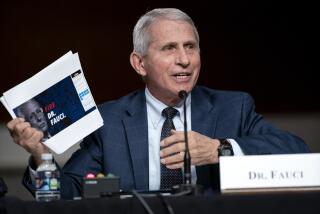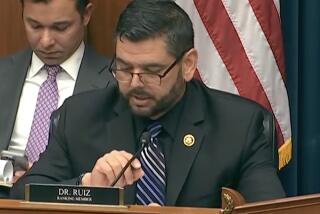Investigation fills in blanks on how war groundwork was laid
- Share via
WASHINGTON — Just four months after the Sept. 11 attacks, then-Deputy Defense Secretary Paul D. Wolfowitz dashed off a memo to a senior Pentagon colleague, demanding action to identify connections between Iraqi dictator Saddam Hussein’s regime and Al Qaeda.
“We don’t seem to be making much progress pulling together intelligence on links between Iraq and Al Qaeda,” Wolfowitz wrote in the Jan. 22, 2002, memo to Douglas J. Feith, the department’s No. 3 official.
Using Pentagon jargon for the secretary of Defense, Donald H. Rumsfeld, he added: “We owe SecDef some analysis of this subject. Please give me a recommendation on how best to proceed. Appreciate the short turn-around.”
Wolfowitz’s memo, released Thursday, is included in a recently declassified report by the Pentagon’s inspector general. The memo marked the beginnings of what would become a controversial yearlong Pentagon project supervised by Feith to convince the most senior members of the Bush administration that Hussein and Al Qaeda were linked -- a conclusion that was hotly disputed by U.S. intelligence agencies at the time and has been discredited in the years since.
In excerpts released in February, Thomas F. Gimble, the acting inspector general of the Pentagon, criticized the project as an alternative intelligence assessment that was improper. However, Gimble said, the operation was not illegal or unauthorized, because Pentagon directives allowed Rumsfeld and Wolfowitz to assign the work.
Many of the activities of the intelligence unit Feith headed are now well-known. But the release of the full inspector general’s report provides more detail about how a group of Pentagon officials and on-loan intelligence analysts were able to shunt aside contradictory reports and convince top administration officials that they had powerful evidence of connections between Hussein’s regime and Al Qaeda. The 121-page report was released by Sen. Carl Levin (D-Mich.), chairman of the Senate Armed Services Committee, and is posted on the senator’s website, levin.senate.gov/.
Feith has said his project was an appropriate, rigorous effort to question assumptions made by U.S. intelligence agencies. On a website Feith set up in response to the inspector general’s report, www.dougfeith.com/, he states: “This IG report controversy is, in essence, a debate over whether the CIA should be protected against criticism by policy officials.” (Emphasis is his.)
The current Defense secretary, Robert M. Gates, has disavowed Feith’s work, saying in his confirmation hearings and in other public statements that he believes all intelligence analysis should be left to the CIA and other intelligence agencies, which are subject to congressional oversight.
Still, Feith’s successor, Undersecretary of Defense for Policy Eric S. Edelman, sent the inspector general a 52-page defense of Feith’s project.
In the critique, released with the report, Edelman said that all the activities labeled as “inappropriate” were authorized by Wolfowitz or Rumsfeld, and that the inspector general’s discouragement of such outside analysis would have a “dampening effect” on future efforts to challenge intelligence assessments.
“Bipartisan reports and studies by various commissions and congressional committees since the 9/11 attacks have stressed the need for vigorous debate, hard questions and alternative thinking of the sort that motivated the work reviewed in this project,” Edelman said.
In making its case for the 2003 invasion of Iraq, the Bush administration cited evidence that Hussein was stockpiling weapons of mass destruction. An important secondary reason was the belief in connections between Iraq and Al Qaeda. Though the CIA has been criticized for erroneously gauging Iraq’s weapons programs, its assessment of Iraq’s ties to Al Qaeda proved more accurate.
The report highlights how much credence the Feith group gave to a purported meeting in April 2001 in Prague, Czech Republic, between Mohamed Atta -- the lead Sept. 11 hijacker -- and Ahmad Khalil Ibrahim Samir Ani, an Iraqi intelligence officer. Briefings that Feith’s office gave to senior officials, including Rumsfeld and then-CIA Director George J. Tenet, listed such a meeting on a list of “known contacts” between Iraqis and the terrorist organization, according to the report.
The report of a meeting, based on a single source who was in contact with Czech intelligence, was widely questioned by U.S. intelligence agencies at the time and was never substantiated.
The Defense Intelligence Agency and the CIA each “published reports that disavowed any ‘mature, symbiotic’ cooperation between Iraq and Al Qaeda,” the inspector general’s report found. “The intelligence community was united in its assessment that the intelligence on the alleged meeting between Mohammed Atta and al-Ani was at least contradictory, but by no means a ‘known contact.’ ”
The report also said Feith tailored his briefings to his audiences: There were at least three versions of the slides he used in different sessions with senior officials.
His Aug. 15, 2002, briefing for Tenet, for instance, omitted a slide titled “Fundamental Problems With How Intelligence Community Is Assessing Information,” which was highly critical of the CIA.
The same slide was included, however, when Feith’s office briefed I. Lewis “Scooter” Libby, then the vice president’s chief of staff, and Stephen Hadley, then deputy national security advisor.
The report said Feith’s criticism of the CIA “undercuts the intelligence community,” pointing to Vice President Dick Cheney’s validation of the material as “your best source of information” on links between Iraq and Al Qaeda.
*
More to Read
Sign up for Essential California
The most important California stories and recommendations in your inbox every morning.
You may occasionally receive promotional content from the Los Angeles Times.










